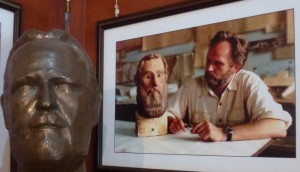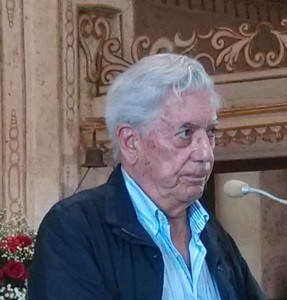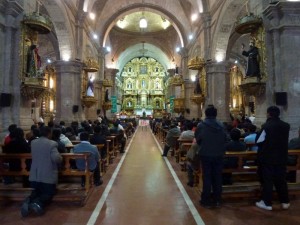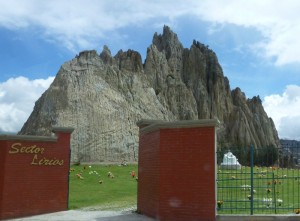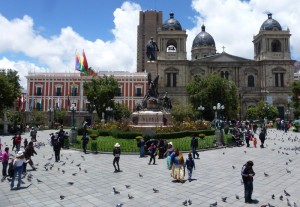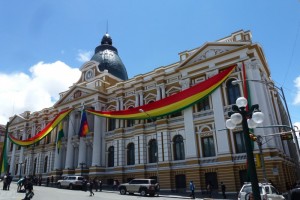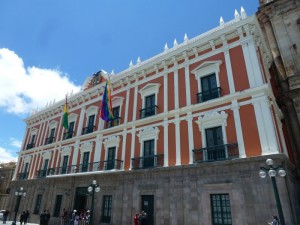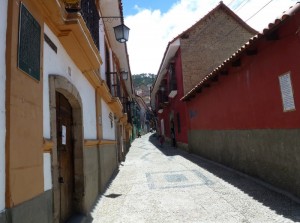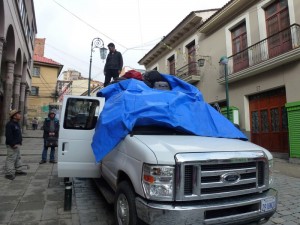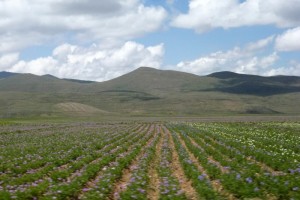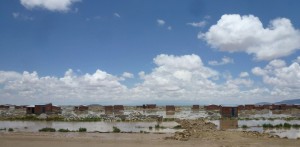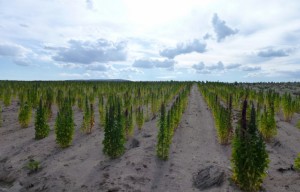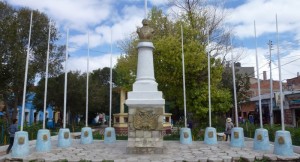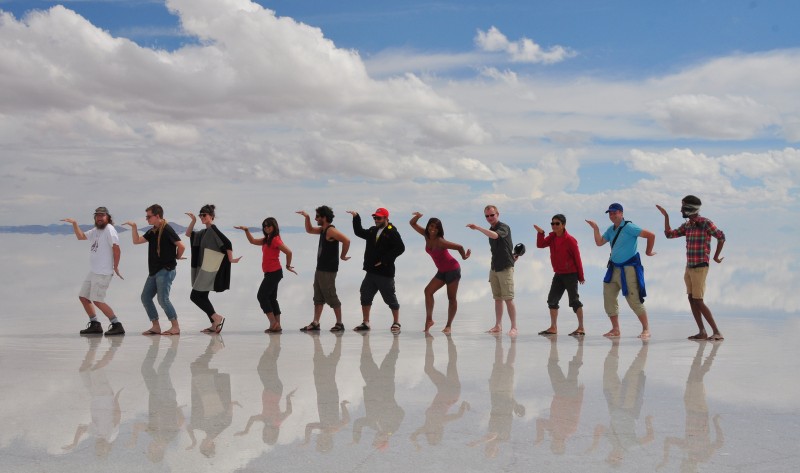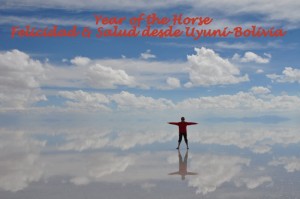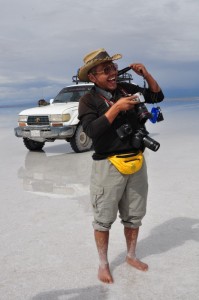Jesuit Missions, La Paz & Uyuni
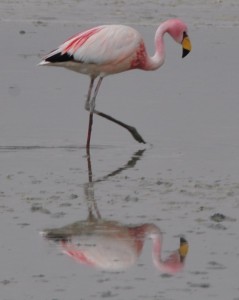 |
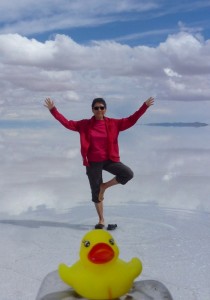 |
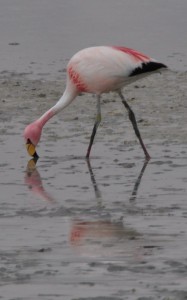 |
January 23 Thursday: Samaipata – Santa Cruz – Concepción (420km)
Though I could stay on for a few more days to take a one-day trek to a volcano lake and a two-day ‘Che Guevara trail’ where the iconic leader of Cuba was imprisoned in Vallegrande and assassinated in the nearby village of La Higuera. But I decided to leave in order to see the Jesuit Missions which is a World Heritage Site.
After breakfast, I walked to the shared taxi stand by the main road. Later a local arrived and both of us hoped to find a taxi to Santa Cruz. Soon, the man saw one taxi coming and jumped in (though I arrived before him). There is no queuing system. I was desperate as I did not know Spanish and was not quick enough to grab a taxi. Then luck fell upon me: I saw a long distance bus coming and waved to the driver. I could not believe when the bus stopped for me. The bus was full and I took the jump seat. The driver did not ask me for money but I paid him B$20. The bus made no stop and I was at the terminal in Santa Cruz around 12 noon.I found a minibus to Concepción and paid B$50. But I waited for half an hour for the bus to be filled. I was back on the road again at 1pm.
Jesuit Missions located across an extensive area of Santa Cruz form an important part of Bolivia’s history. In 1990 six Jesuit Missions founded in San Javier in 1691, San Rafael de Velasco in 1695, San José de Chiquito in1698, Concepción in 1699, San Miguel de Velasco in 1721 and Santa Ana de Velasco in 1755 were grouped together as a World Heritage Site because of its unique fusion of European and Amerindian cultural influences. They all have beautiful murals, altars, columns and pulpits made of wood in the mestizo Baroque style. In 1772 the Jesuits were expelled by the Spanish as they believed the Jesuits had gained too much influence over the native people. The mission churches were decaying till 1980s when Swiss Jesuit and architect Hans Roth led the restoration project to restore the temples to their former glory.
There is paved road up to San Javier. But there are many potholes and some parts are unpaved. I arrived in Concepción about 6pm. It was getting dark and I asked for direction to the church. I was given the impression it was many blocks away. I do not like walking in the dark. So I took a room in the first guesthouse I came across which looks tidy with a nice garden. I paid B$50 for a single room without private toilet and breakfast. (I wish I had walked to the village centre which might take 10-15 minutes as there are several nice hotels. I like Apart Hotel Las Misiones next to the police station which charges BS150 for a room with toilet and breakfast. What a pity!) As I had nothing to do, I went to bed early and began my tour of Concepción before 7am the following day.
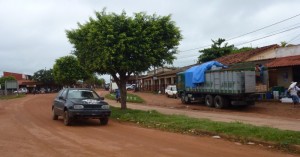 |
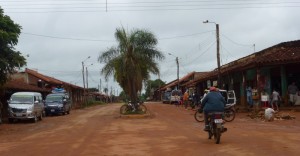 |
January 24 Friday: Concepción – San Javier – Santa Cruz (300km) I left my backpack at the reception and made my way to the village centre. The red soil, muddy and unpaved road, lush vegetation and colonial architectures have given the town a unique feel and appearance. The square with gigantic mature trees is the best one I have seen so far. 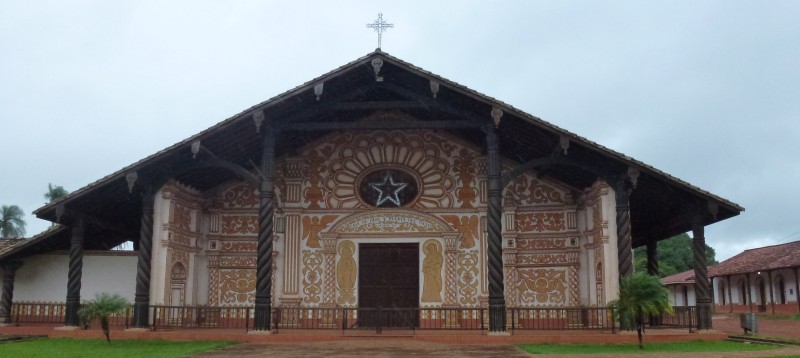
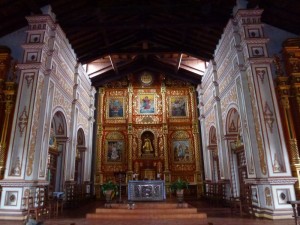 |
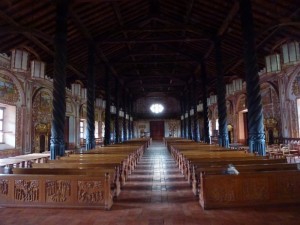 |
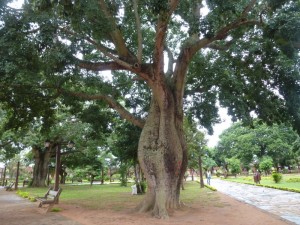 |
The entrance fee for two museums and the church is B$25. The first museum presents basic information on all the six churches with some restored items. The second one next to the church are mainly related to the church. I finally entered the church which has been meticulously restored with tall wooden columns. The bell tower with twisting columns and winding staircase is elaborate.
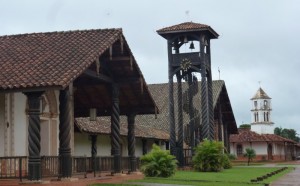 |
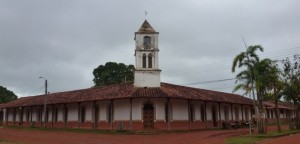 |
 |
 |
 |
As I want to see the oldest church at San Javier as well, I had to move on quickly as museums normally close between 12 noon and 2pm. On my way back to the guesthouse, I saw a native lady selling cooked food. The utensils looked spotlessly clean and there were beef, pork, chicken and potatoes. I took a portion of rice with chicken for only B$10. It is the best stew chicken I had so far on this trip!
There is a daily bus for Santa Cruz departing at 10:30am. But it did not leave till almost 11am. As a result, by the time I arrived in San Javier, it was after 12noon. I expected the church to be closed and had to wait till 2pm. To my surprise, I heard sounds coming from the church which doors were wide open. I saw a big gathering. Then I recalled someone had told me that Mario Vargas Llosa, winner of the Nobel Prize in Literature 2010 would be in the area.
I was lucky to get a glimpse of this writer from Peru who has also run for presidency. At the end of the ceremony, the local residents dressed in traditional dresses and four men wearing masks performed a welcoming dance. I was really lucky to witness all these! Shirley, a reporter from Santa Cruz took a picture for me! 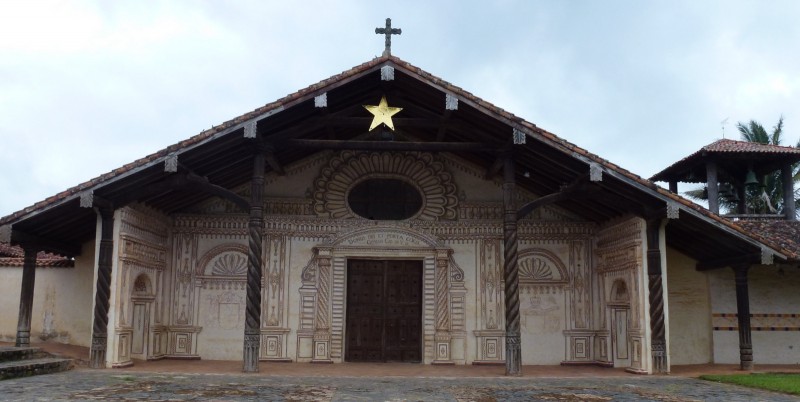
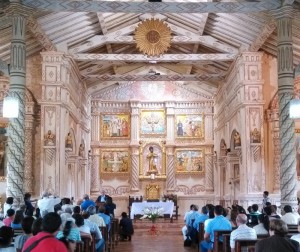 |
|
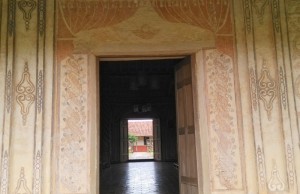 |
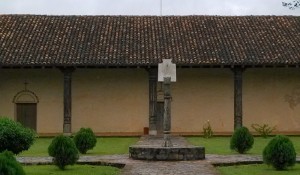 |
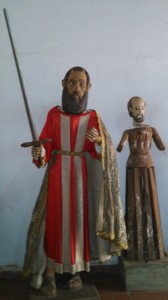 |
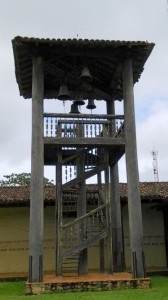 |
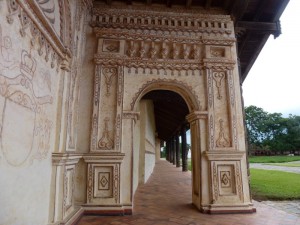 |
I was excited and felt exhilarated with this side trip. The carving in this church is totally different from those in Concepción with wood in beige colour and simple and patterned carving. I find the courtyard and bell tower simpler, more serene and beautiful. All the churches have their own style and I wish I could see all of them.
It was after 1pm. As the bus would not be coming till 2:30pm, I decided to take a micro. The driver told me he was still waiting for more passengers. But if I am prepared to pay B$70 i.e. price for two persons, he would go. I agreed and took two seats in the front. Five passengers jumped in and we set off immediately. They got off at San Ramos and the driver picked up four more passengers on the way to Santa Cruz.
It started to rain. I arrived at the bus terminal at 5:30pm and purchased an 18-hour bus ticket for La Paz the following day for B$220. This would be the longest bus journey for me! I walked back to the Jodanga Backpackers’ Hostel and was warmly greeted by the receptionist. The weather was getting worse. I did want to go out and just had a few Brazilian nuts that I bought with Kamlya in Sao Paulo.
January 25 Saturday: Santa Cruz – La Paz (3650m)
Torrential rain poured down relentlessly the whole night. I had a nice sleep but got so cold that I decided to get up at 7am. My initial plan was to have a good lunch and to leave for the terminal at 2pm. It continued to rain the whole morning. So instead of going out for lunch, I went into the kitchen to look for food to eat. Luckily I found some spaghetti and a packet of asparagus soup power in the common food cupboard. I ended up having a healthy lunch for nothing.
At 2pm, I took a taxi to the terminal. But the lady who sold me the ticket tried to tell me something when I turned up at the counter. Finally a local who speaks English explained to me that the road to La Paz had been closed owing to the heavy rainfall and all buses had been cancelled. He told me there would be a plane at 6pm and suggested me take a taxi to the airport to get a ticket.
As a matter of fact, I had originally planned to fly to La Paz as an online ticket would cost around US$110-120. But as my credit card had been locked when I had input the wrong verification pin number, I could not buy a ticket online. Hence I thought it would be a good idea to try out an 18-hour bus journey. After all, I had to take the plane as my 12-day tour would start in La Paz on January 26.
I paid B$70 for a taxi to the airport. A nice airline staff sold me a ticket for the 7:30pm flight for US$104. But he told me to return around 5:30pm to see whether I could get on the 6pm flight. I did and was able to take the earlier flight. Anyway, it was delayed and I did not arrive in La Paz till 8pm. I had been very lucky and by 10pm, I had already lying in a warm bed in the Eva Palace Hotel in the old town where the group would stay.
12-day Bolivia Highlight Tour January 26 – February 6
La Paz founded in 1546 is the administrative capital of Bolivia and the metropolitan area has a population of over 2.3 million. On July 16, 1809, Pedro Domingo Murillo rose in revolt in La Paz against the Spanish formally marking the beginning of the liberation of South America from Spain. The city located in the valleys of the Andes is close to the Eastern split of the Altiplano region and surrounded by high mountains such as the Illimani, Huayna Potosi, Mururata and Illampu.
January 26 Sunday: La Paz
I had a leisure day waiting for the group meeting to be held at 6:30pm. In the morning, I went to the San Francisco Church (founded in 1548 and rebuilt in1784) next to the hotel. I saw many native women wearing their best traditional dress and prayed earnestly. Instead of having traditional organ church music, a musician played delightful guitar music of the 60s and 70s. The atmosphere was lively and cozy.
I walked around the area around Saranga Street which is filled with travel agencies, souvenir shops, hostels and eateries. I went to a few agencies with a viewing to finding a couple of tours to take after the 12-day tour with Intrepid. By 11am, I was hungry and stopped at La Cueva, a Mexican bar-restaurant for a set unh for B$40. I spent the whole afternoon working on my travel notes in Bolivia.
At the group meeting, I met our local guide, Pepe, and eight participants including five Australians (Sarah and Trent, Mo, Ryan and Dwan), two Belgians (Jan and Nick) and a Canadian (Ross). I had an excellent Thai dinner at Thai Old Town for only B$50.
January 27 Monday: Sightseeing in La Paz
Pepe took us on a city tour in a minibus (which cost us only B$23 each). We started off at the Moon Valley which has changed so much since my last visit in 1988. Today, housing and commercial developments including a 9-hole golf course encroached upon the sculptured clay and sandstone landscape which is no longer magical and impressive.
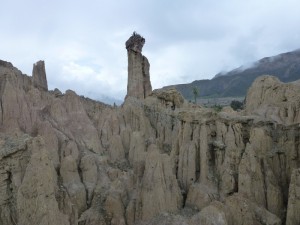 |
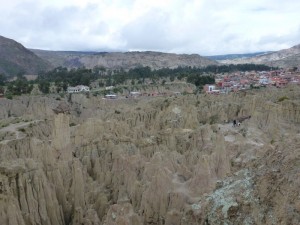 |
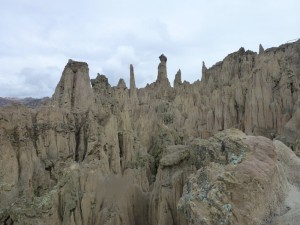 |
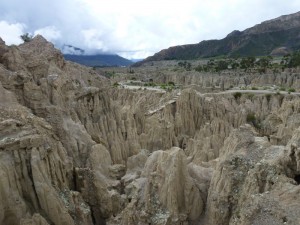 |
Our next stop was the city lookout point at Monticulo, followed by a visit to the Murillo Square which is the civil centre of La Paz. In the centre of the square stands the statute of Murillo, the spot where he was hanged in July 1809. The square is surrounded by magnificent colonial buildings including the Metropolitan Cathedral of La Paz (built in 1835) and the Presidential Palace. It was a sunny day and many locals were sitting under the trees.
Our final stop before lunch was Calle Jaen which is lined with beautifully restored colonial buildings including a house where Murillo lived. All the buildings are now museums. Pepe took us to a restaurant close to our hotel where I had quinoa risotto. Quinoa has become popular in recent years owing to its nutrition. Bolivia owing to its weather and soil condition is the world’s largest producer of quinoa.
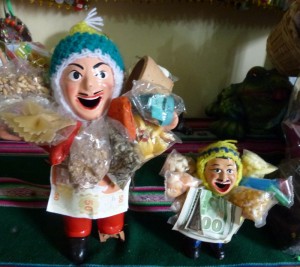 |
I asked Pepe to find me a camera shop to fix the new filter. He took me to a shop across the road and I paid B$70 for an excellent service. I mentioned my interest to learn Spanish to Pepe who introduced me to his friend at Pico Verde, a language school close to the hotel. So I took a 2-hour lesson with Xiomara for B$110. I hope to take 10-15 hours of lessons before leaving Bolivia in end February.
January 28 Tuesday: La Paz – Uyuni (3700m) (550km)
We had a long driving day and had a brief lunch stop at Oruro. The road from La Paz to Oruro is mostly paved but construction works is still going on. It is amazing to see most of the land along the road is under cultivation. The main crops include potatoes and quinoa. Pepe said that a 2-acre land of quinoa could fetch as much as US$10,000 a year.
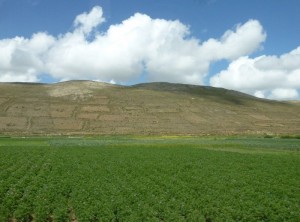 |
Around 4pm, we arrived at Challapata where we switched to two 4×4 vehicles. Ross, Sarah, Trent, Dwan and I were in one vehicle and Hector was the driver. An hour later, our vehicle had a flat tire and Hector took half an hour to fix it. I was glad to have a chance to get out of the vehicle to breathe fresh air, take a closer look at the plants and watch llamas munching happily along a stream. The sunset was beautiful.
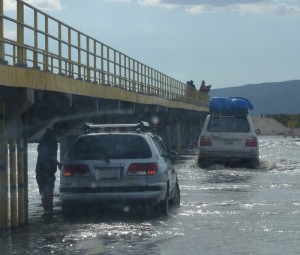 |
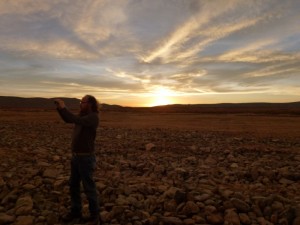 |
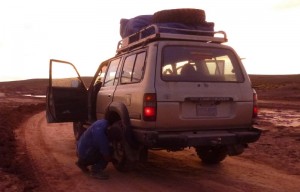 |
Unfortunately, Dwan who had symptoms of altitude sickness since arrival in La Paz experienced insufferable headache on the way to Uyuni. As soon as we arrived in Uyuni after 8pm, Pepe took her to the hospital. It was after 9pm when we checked in a hotel. I skipped dinner as I was not hungry after having eaten a grilled leg of lamb in Oruro. I was half asleep when Dwan came back from the hospital. She had taken some medication and her condition had improved. I heard her moaning during the night.
January 29 Wednesday: Uyuni – Culpina (about 200km)
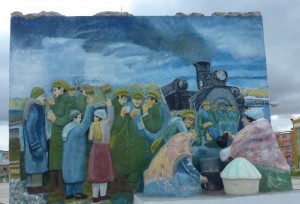 |
Uyuni is the base of starting a 3-day 4×4 tour to Salar de Uyuni, world’s largest salt flat at 3653m with an area of 12,000 km², the desert and the Eduardo Avaroa Andean Fauna National Reserve. We had a good breakfast and a late start. I felt like on vacation here. We first went to the Cemetery of Trains which is about 3km away. In the middle of nowhere, I saw a waste land with dozens of abandoned old steam locomotives and rail cars.
Then we made our way to Colchani and saw how salt was made as a cottage industry. It’s time for lunch and we had lunch in a house built with salt.
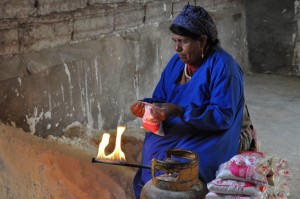 |
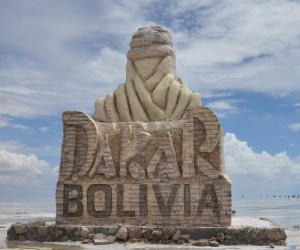 |
After lunch, we headed to Salar de Uyuni where we spent a couple of hours walking excitedly on the salt flat covered with water. The reflections are awesome and surreal. We could not stop posing and taking photos! In the dry season, the flat is dry and white with a totally different scenery and feel.
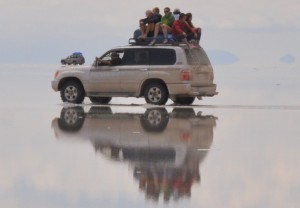 |
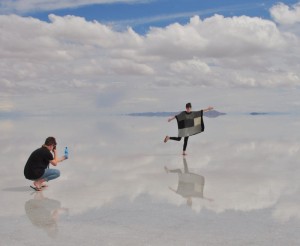 |
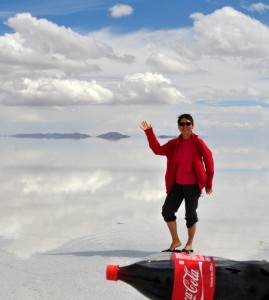 |
I was sad to leave and would love to return to appreciate its magnificence in the dry season. We did not have a long drive and arrived at a guesthouse before 6pm. The temperature dropped a lot and I was freezing as I had left my down jacket in my overnight bag. We had a good meal with vegetable soup and fried chicken. I shared a room with Mo and Ryan.
January 30 Thursday: Culpina – Laguna Colorada (200km)
We set off at 8am. Today, the scenery and topography are totally different with desert, rocks, volcanos and lagoons. We had a leisure day with five stops. Valley of Rocks – Rocks in different shapes and sizes spread over an extensive area. It would be nice to spend a day instead of half an hour strolling in the area. I took a picture with a huge rock in the shape of a condor.
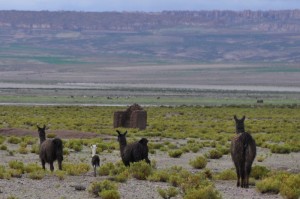 |
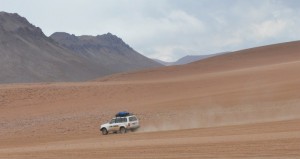 |
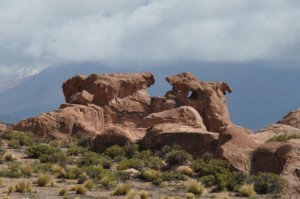 |
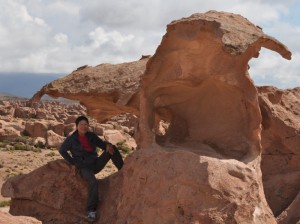 |
Laguna Turquiri – It was the first lake we visited today. It is small but beautiful with lots of black coots. I even saw two lizards copulating in the sun.
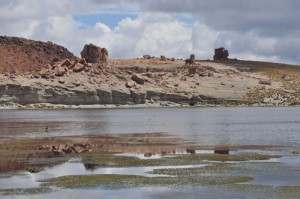 |
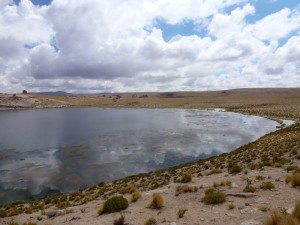 |
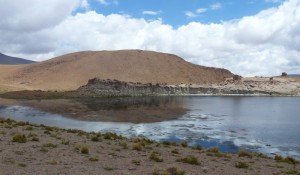 |
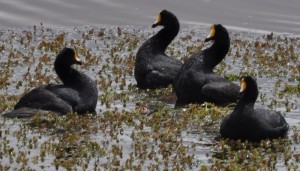 |
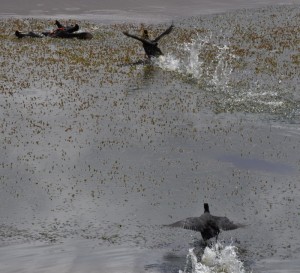 |
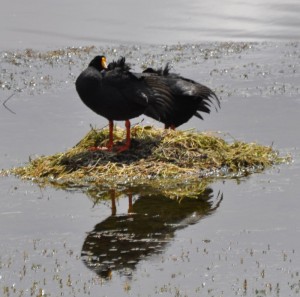 |
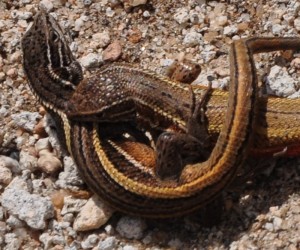 |
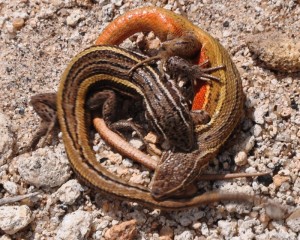 |
Laguna Cachi – I find this small lagoon atmospheric. The weather changed and the sky blackened shortly after our arrival. I took a few good pictures of Chilean flamingos.
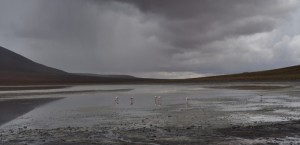 |
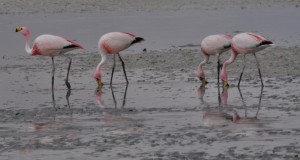 |
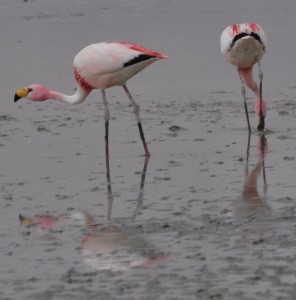 |
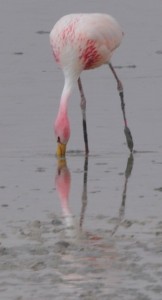 |
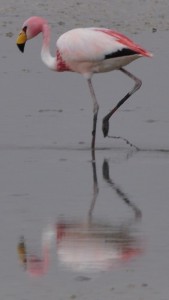 |
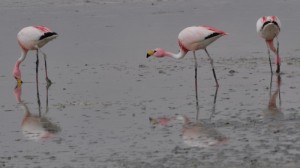 |
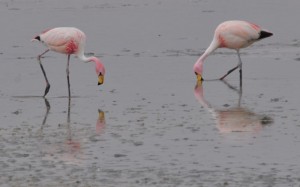 |
Laguna Khara – The sun was nice and warm. We had a nice picnic lunch by the lake.
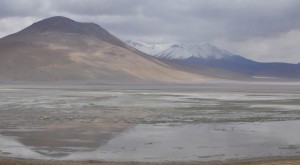 |
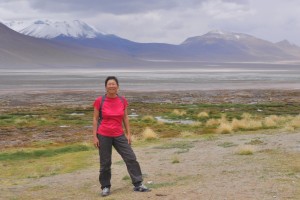 |
 |
 |
Stone Tree – Rocks scatter around in the middle of the desert. The most iconic one is the Stone Tree.
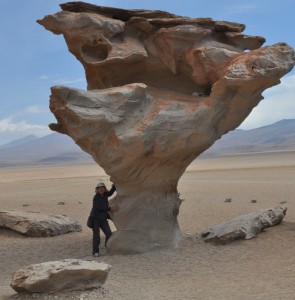 |
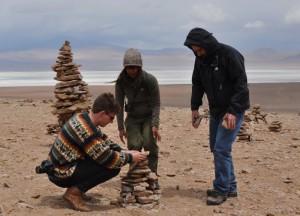 |
Laguna Colorada (Red Lagoon) – It is a shallow salt lake within the Eduardo Avaroa Andean Fauna National Reserve. The lake contains borax islands whose white colour contrasts with the reddish colour of its water. I saw James’ Flamingos as well as the Andean and Chilean flamingos. We entered the national reserve around 4pm and checked in a basic lodge close to the entrance.
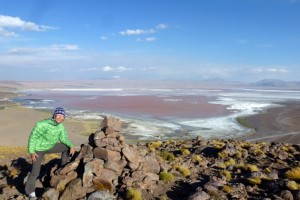 |
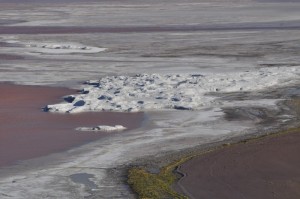 |
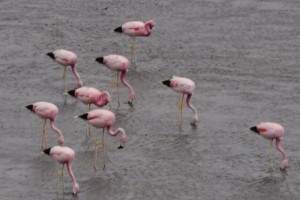 |
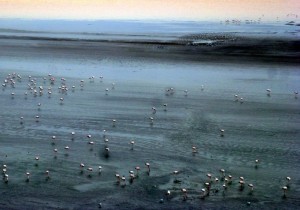 |
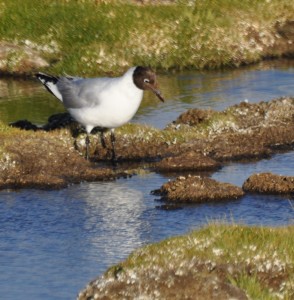 |
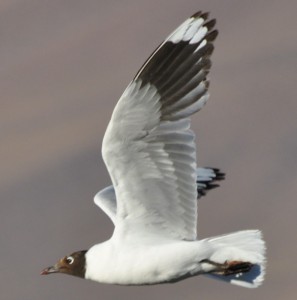 |
After a nice cup of tea, I joined Pepe and Ross on a walk while others played card in the lodge. I had a nice panoramic view of the lake with eerie colours. I also had a short walk along the lake. I paid B$15 for a hot shower before dinner. We had spaghetti and Ross treated us with two bottles of red wine. Though I only had two small glasses, I felt my heart beating unusually fast and could not sleep. I must be careful and should avoid drinking alcohol.
January 31 Friday: Laguna Colorada – Uyuni (about 400km)
We got up at 4:30am and set off at 5am. After an hour’s drive, we arrived at the 4950-m high Sol de Mañana geyser basin with boiling mud pots and sulfurous fumaroles. I have seen similar features in Iceland, Japan, Chile and Kamchatka, Russia. The experience here is different: one can walk around freely and safely. The temperature is not exceedingly high and the smell is tolerable. I saw the sun rising through smokes and steam. A surreal experience!
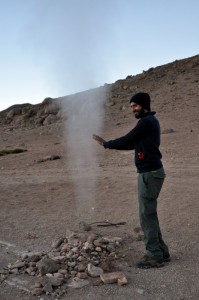 |
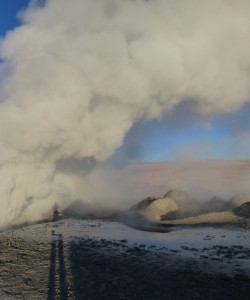 |
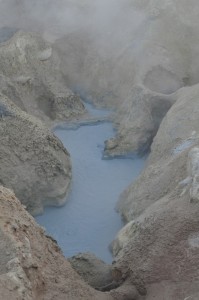 |
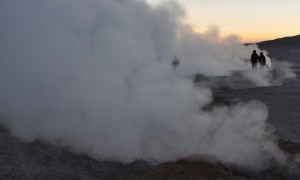 |
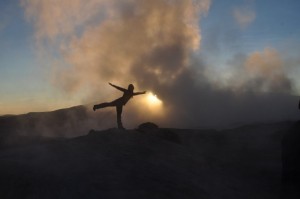 |
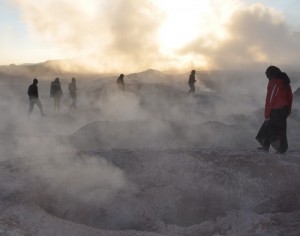 |
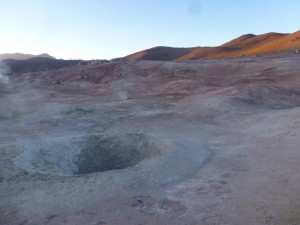 |
Pepe’s original plan was to let us have breakfast and a soak in the hot spring before going to Laguna Verde. But the small pool was already packed. Pepe changed the plan and we moved on after a quick breakfast. I had a wonderful time watching the llamas walking pass the hot spring.
 |
 |
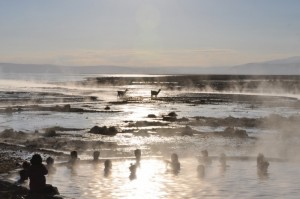 |
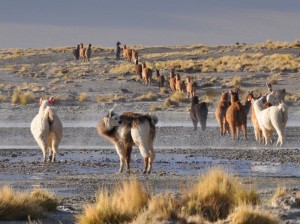 |
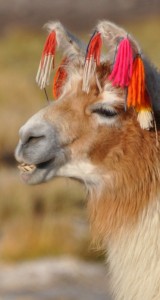 |
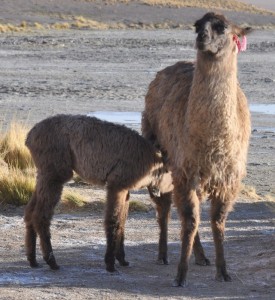 |
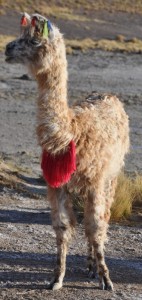 |
The drive to Laguna Verde through the desert is short but beautiful. The desert is expansive with multi-coloured mountains.
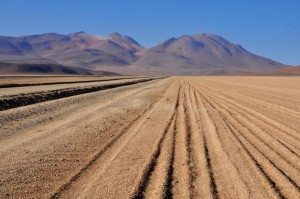 |
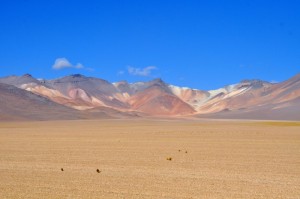 |
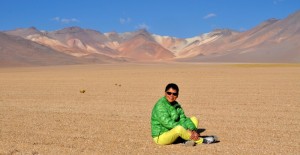 |
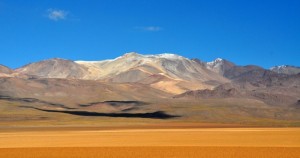 |
I visited Lagoon Verde (5000m) planked by a 5930m cone of Volcán Licancabur in 1999. At that time, I found the lagoon and the adjacent Laguna Blanco beautiful and awesome. Today, Lagoon Verde is no longer green. There are also fewer flamingos in Laguna Blanco. What a pity!
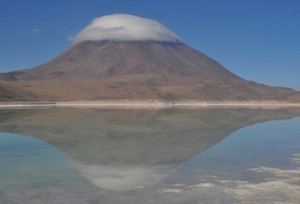 |
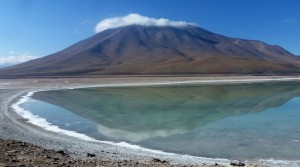 |
The hot spring was empty by the time we got there: we had the pool to ourselves. The water is lovely (about 35ᴼC). I relaxed in the hot spring while watching the flamingos, the Andean seagulls and the distant snow-cladded mountains and enjoying the tranquility and emptiness.
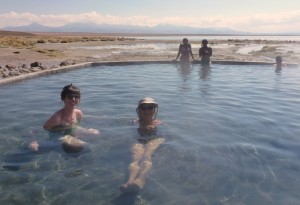 |
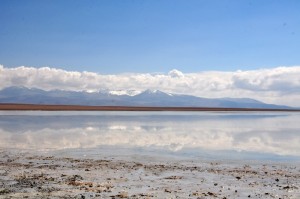 |
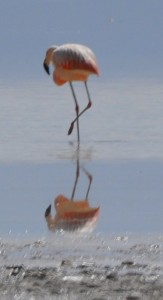 |
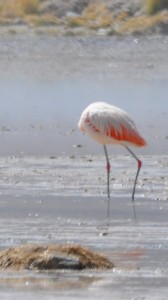 |
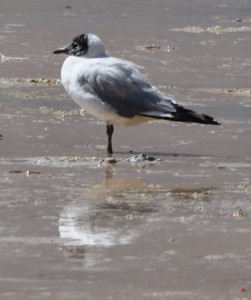 |
We had a long drive back to Uyuni and had only two stops to stretch the legs and to look at some rocks.
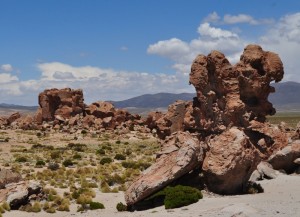 |
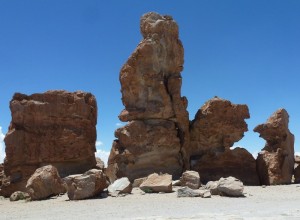 |
The road was bumpy and I was thrown up from my seat as there was no seat belt for two seats at the back. My head hit on the roof and pain shot through my neck and my right arm. Fortunately no permanent damage had been done. As the dirt road is dumpy and unsafe, I believe seat belts should be installed in all vehicles.
Around 2pm, we arrived in Vila Atola. Mario and Hector (the drivers) tried to find a lodge to cook a meal for us. As the locals were busy working in the quinoa fields, they told us to get off and drove away to sort out our lunch. Pepe then went looking for them while we sat in the street without knowing what was happening. We thought we had been abandoned! Eventually Pepe reappeared and took us to a lodge where our lunch with sausage, mesh potatoes and salad were already laid on the table.
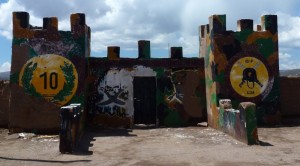 |
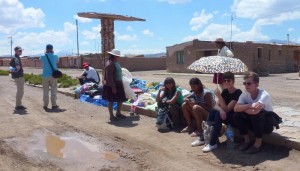 |
It was about 3:30pm when our 4X4 hit the road again. We had a 30-minute break in San Cristôbal as Hector went off for his lunch. We got back to Uyuni around 6:30pm and could not wait for a nice hot shower. Pepe took us to a nice restaurant where I had a llama steak. It was Chinese New Year day and I took a sip of red wine.


